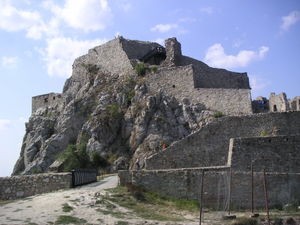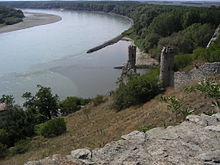- Devín Castle
-
Devín Castle
Devínsky hradBratislava  Devín
Devín
Slovakia
The ruins of Devín CastleType Castle Built 864 – 15th century
Last forifications built in the 17th centuryCurrent
conditionRuins (partially reconstructed) Open to
the publicnonstop, opening hours apply to the museum Controlled by Great Moravia, Kingdom of Hungary, Czechoslovakia, Slovakia Events Notable events in the castle's life: - Blown-up during the napoleonic wars in 1809
Devín Castle (Slovak: hrad Devín or Devínsky hrad, Hungarian: dévényi vár, German: Burg Theben) is a castle in Devín, which is a borough of Bratislava, the capital of Slovakia.
Owing to its strategic position, the cliff (altitude of 212 meters) at the confluence of the Danube and Morava rivers was an ideal place for a fort. Its owner could control the important trade route along the Danube as well as one branch of the Amber Road. That is why the site has been settled since the Neolithic and fortified since the Bronze and Iron Age. Later, both the Celts and the Romans built strong fortresses there. In the Roman ruins, the first Christian church located North of the Danube has been identified.
The castle stands just inside Slovak territory on the frontier between Slovakia (previously part of Czechoslovakia) and Austria. The border runs from west to east along the Morava River and subsequently the Danube. Prior to 1989, the Iron Curtain between the Eastern Bloc and the West ran just in front of the castle. Although the castle was open to the public, the area surrounding it constituted a restricted military zone, and was heavily fortified with watchtowers and barbed wire. After the Velvet Revolution the area was demilitarised.
The most photogenic part of the castle is the tiny watchtower, seemingly not much bigger than a chess piece, known now as the Maiden Tower. Separated from the main castle, it balances perilously on a lone rock and has spawned countless legends concerning imprisoned lovelorn daughters leaping to their deaths.
Inside, the castle is a sprawling landscape of walls, staircases, open courtyards and gardens in various states of repair. They are all, however, made readily accessible by a continuing restoration and archaeological project conducted since the borough of Devín was reclaimed from Nazi Germany which annexed it shortly before World War II.
Contents
History
A Slavic castle, founded in the 8th century, played a crucial role during frequent wars between Great Moravia and the Franks.[citation needed] The claims that Devín or neighboring Pressburg was the center of Samo's Empire cannot be proven.[citation needed] The ancient name of the castle (Dowina - from the Slavic/Slovak word deva for girl) was mentioned for the first time in written resources in 864, when Louis the German besieged Prince Rastislav in the "castle of Dowina". During the Great Moravian period, a Christian church had been built in the complex. Its distinct style was probably inspired by similar churches in Byzantine Macedonia, from where Saints Cyril and Methodius came to Great Moravia.[citation needed] Chemical composition of frescoes indicates that the church was decorated by Italian painters. On the other hand, the identification of Dowina with Devín Castle has been under debate[1] based both on linguistic arguments and the absence of convincing archaeologic evidence.[2]
In the 13th century, a stone castle was built to protect the western frontier of the Hungarian Kingdom whose existence was documented in 1271 and a reference to a castelanus de Devin appeared in 1326. Between 1301 and 1323, the castle (together with Pozsony county) was held by the Dukes of Austria who granted it to Otto von Tellesbrunn. In 1323, the dukes transferred Pozsony county back to King Charles I of Hungary and Devín Castle became the possession of the heads (ispán) of the county. In 1385, the castle was occupied by Margrave Jobst of Moravia who held it until 1390 when King Sigismund of Hungary redeemed it. Later, the king mortgaged Devín Castle to an Austrian knight, Lessel Hering who transferred the castle to Nicholas II Garay (the Palatine of the kingdom) in 1414. Around 1444, King Frederick IV of Germany occupied the castle but he granted it to Ladislaus II Garay already in 1450.
A palace was added in the 15th century. Fortification was reinforced during wars against the Ottoman Empire. The Castle was never taken, but after the Hungarian Kingdom joined the Habsburg Monarchy and the Ottomans were finally defeated, it ceased to be an important border fortress and was no longer used by the military. Stephen Báthory got the castle by the king as a donation. But according to Stephen Báthory was Keglević the owner of the castle. Keglević pawned the castle for 40,000 guilders to the Palocsai family and spent the money. In 1609, Matthias II confirmed that Keglević still was the owner of the castle, but Keglević did not have the money to take the castle out of pledge from the Palocsai family. Nearly 100 years later in 1635 Palatine Pál Pálffy took the castle out of pledge from the Palocsai family.[3] The last owners of the Devín Castle were the Counts of the Pálffy family. Only in 1809, after the Siege of Pressburg, was the castle (still considered a threat) destroyed by the retreating forces of Napoleon I of France. Napoleon and Leopold Pálffy negotiated then and they both agreed that Vienna is supplied with products by Pálffy.[4]
Since the 19th century, Devín has become an important national symbol for the Slovaks. It featured on the 50 Halierov coin of the Slovak currency. Its history even inspired several Romantic poets, followers of Ľudovít Štúr.
The Hungarians regarded it as the western gateway of the Kingdom of Hungary. The Hungarian poet Endre Ady used it as a symbol of modernism and Westernization in his poem I am the Son of Gog and Magog:
By Verecke's historic route I came,
In my ear ancient Magyar songs still blaze,
Am I free to break through at Dévény,
With modern songs fit for modern days?—Endre Ady: I am the Son of Gog and Magog[5]Some parts of the castle have been reconstructed in the 20th century and the castle hosts an interesting museum.
See also
References
- ^ Kristó, Gyula (editor) (1994). Korai Magyar Történeti Lexikon (9-14. század). Budapest: Akadémiai Kiadó. p. 553. ISBN 963 05 6722 9.
- ^ The vowel "o" of Dowina cannot be explained from "e", and all the documented names of Devín contain a front vowel: e.g., Devín, Theben, Dévény (http://www.uni-bonn.de/~ntrunte/publikationen8.html#dowina_inhalt).
- ^ Presburg und seine Umgebung, C.F. Wigand, 1865.
- ^ The History of the Rise, Progress, and Overthrow of Napoleon Bonaparte: With a Summary Account of the Circumstances which Paved the Way to the French Revolution Together with a History of the Wars, page 650, Theophilus Camden, J. Stratford, 1814.
- ^ László, Gyula (1996). The Magyars - Their Life and Civilisation. Corvina. p. 355. ISBN 963 13 4226 3.
Sources
- Engel, Pál: Magyarország világi archontológiája (1301–1457) (The Temporal Archontology of Hungary (1301-1457)); História - MTA Történettudományi Intézete, 1996, Budapest; ISBN 963-8312-43-2.
External links
- Short description of Devín Castle
- The lack of archaeological evidence when identifying Devin Castle with Dowina
- Defending Bratislava at Devin - Spectacular Slovakia
- History, pictures, and google map of Devín Castle
Coordinates: 48°10′25″N 16°58′42″E / 48.17361°N 16.97833°E
Categories:- Castles in Slovakia
- Archaeological sites in Slovakia
- Buildings and structures in Bratislava
- Great Moravia
Wikimedia Foundation. 2010.


